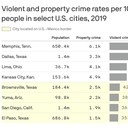11 border cities have a combined violent crime rate below the national average

U.S. communities along the Mexico border are among the safest in America, with some border cities holding crime rates well below the national average, FBI statistics show.
Why it matters: The latest crime data collected by the FBI from 2019 contradicts the narrative by President Trump and others that the U.S.-Mexico border is a "lawless" region suffering from violence and mayhem.
- Crime in U.S. border cities remains low even though sister cities in Mexico are among the most dangerous in North America because of cartel violence.
- From Brownsville, Texas, to San Diego, safe border cities have majority-Hispanic populations and poverty rates above the national average.
By the numbers: An Axios analysis of the crime data from 11 border communities found the cities had combined a violent crime rate (per 100,000 residents) of 338.5. The FBI says the estimated rate of violent crime nationally was 366.7 for the same time period.
- Some border towns had much lower rates than non-border cities of their same size and similar income demographics.
- McAllen, Texas, a city of 145,000, had a violent crime rate of 96.6, while Kansas City, Kansas, a city of 153,000, had a violent crime rate of 705.7, according to the Kansas Bureau of Investigation.
- El Paso, Texas, a city of 687,000, saw a violent crime rate of 353.7. Memphis, Tennessee, a city with a slightly smaller population, posted a violent crime rate of 1,901.4.
- All 11 border cities had a lower violent crime rate than Sioux Falls, South Dakota. That midwestern city had a rate of 483.2.
Flashback: Trump said in his 2019 State of the Union address: "The lawless state of our Southern Border is a threat to the safety, security and financial well-being of all Americans.”
- He called out El Paso, saying it "used to have extremely high rates of violent crime — one of the highest in the country, and considered one of our nation's most dangerous cities. Now, with a powerful barrier in place, El Paso is one of our safest cities."
Reality check: Border cities have been seeing low crime rates for years. Border Patrol arrests were down 76% in 2018 from a peak of more than 1.6 million in 2000, the Associated Press reported.
- Violent crime has been dropping in El Paso since 1993 and was at historic lows before a border fence was authorized by Congress in 2006.
What they're saying: Steve Ortega, a lobbyist and an El Paso attorney, says calling El Paso dangerous is tantamount to "race-baiting."
- McAllen Mayor Jim Darling said his city has seen crime fall for 31 years in a row. "Everyone just dismisses us a dusty little border town and media show images of the wall and detention centers. That's not the whole picture," Darling said.
- "It's always been safe down here," said Nogales, Arizona, Mayor Arturo Garino, a retired police officer and Vietnam War veteran. "We leave our doors unlocked at night. We're not worried about home invasions to drive-bys like up north."
Between the lines: Federal agencies have become one of the largest employers in border cities.
- Border cities over the last two decades have seen a surge of federal law enforcement agencies dispatched to the region, which may have played a role in reducing crime, said Brudnick Center on Violence and Conflict co-director Jack Levin.
- U.S. Customs and Border Protection says Latinos make up 33% of its 63,900 total workforce. Latinos also make up a little more than 50% of the Border Patrol, according to 2016 data.
- Daniel Garza, president of the Libertarian-leaning LIBRE Initiative, said CBP employees have integrated themselves into border communities.
- Some Latinos say "abolish ICE" slogans and anti-border patrol rhetoric in non-border cities hurt Biden in traditionally Democratic-learning South Texas counties where Latinos voted for Trump in larger than expected numbers.
- The U.S. Border Patrol has grown from 9,212 agents in 2000 to nearly 20,000 in 2018.
- Garino said almost every block in Nogales, a city of 20,000, has someone working in law enforcement living on it.
The big question: How will Latino voters in border cities respond in future elections, if Republicans continue to portray the border region as lawless while some Democrats call for the abolition of U.S. Immigration and Customs Enforcement?